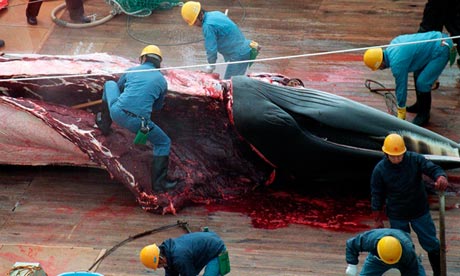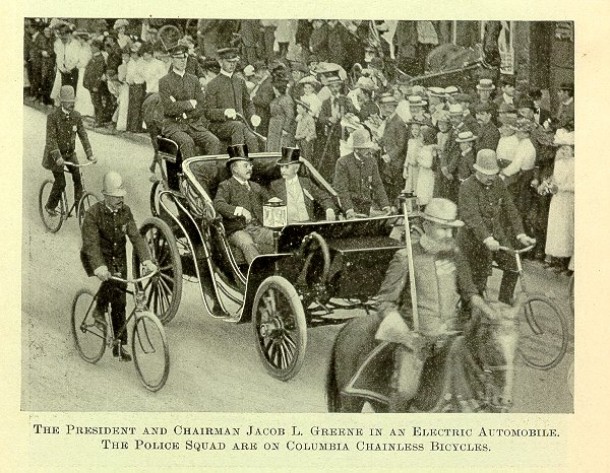Christianity: Good or Bad for Mankind? — Dinesh D’Souza vs. Andrew Bernstein (YouTube link)
Here is the debate in a more compact format, divided near the middle, for portable devices:
Part 1
 |
| Put a whale in your tank. |
It is a fantastically surreal propostion. An Icelandic whaler, Kristján Loftsson, is powering his whaling ships using "biofuel" composed of 80% diesel – and 20% whale oil. Loftsson claims the oil is additionally friendly to the environment as it is rendered out of whale blubber using heat from Iceland's volcanic vents.It is even more organic than first blush, with the geothermal aspect added in.
 |
| 1902 Electric |
It's not the first time animal fat has been used to feed the whale hunt: 20th-century whaling operations in the Southern Ocean made similar use of penguins, throwing the oil-rich animals on fires as living kindling.
 |
| Imagine one of these running on whale oil! |
The term apparently was coined by bus drivers who inadvertently stopped for cues of riders looking for car rides, who would waive off the buses, and the dedicated public servants deemed them counterfeit bus riders.Slugging is a term used to describe a unique form of commuting found in the Washington, DC area sometimes referred to as "Instant Carpooling" or "Casual Carpooling". It's unique because people commuting into the city stop to pickup other passengers even though they are total strangers! However, slugging is a very organized system with its own set of rules, proper etiquette, and specific pickup and drop-off locations. It has thousands of vehicles at its disposal, moves thousands of commuters daily, and the best part, it’s FREE! Not only is it free, but it gets people to and from work faster than the typical bus, metro, or train. I think you'll find that it is the most efficient, cost-effective form of commuting in the nation.
The system of slugging is quite simple. A car needing additional passengers to meet the required 3- person high occupancy vehicle (HOV) minimum pulls up to one of the known slug lines. The driver usually positions the car so that the slugs are on the passenger side. The driver either displays a sign with the destination or simply lowers the passenger window, to call out the destination, such as "Pentagon," "L’Enfant Plaza," or "14th & New York." The slugs first in line for that particular destination then hop into the car, normally confirming the destination, and off they go.Well, no it is no free ride either. All that HOV talk above comes with hefty fines if drivers do not follow all of the stupid commuting rules in the DC area. I may cover the stupid inefficiency of HOV lanes in another post. Anyway, about 35 years ago a system developed where some people picked up riders to get around the stupid rule. The website continues to inform readers that no money is exchanged, which is not strictly true. No cash is exchanged, but both driver and riders get an economic benefit. In Northern Virginia, the benefit to drivers can be seen in the schedule of fines:
Northern Virginia HOV Lane Fines: First offense: $125If you are an outsider who thinks this is something that is easy to get away with, therefore the risk of being fined is negligible, you have another think coming. Every jurisdiction in the area that has an HOV lane passing through it, has a whole shift of cops standing by to ticket anything illegally moving in those lanes, as well as ticketing plenty of folks who were not doing anything illegal at all.
Second offense: $250 plus 3 points on your driving record
Third offense: $500 plus 3 points on your driving record
Fourth offense: $1,000 plus 3 points on your driving record
 Somehow, some way, this massive gypsy cab system is tolerated, encouraged even, by the local constabulary. It would not even exist if the governments that be had not created the HOV system in the first place. The Slug-Line.Com cites that in 1975 the HOV lanes were "opened to carpools and vanpools". Odd choice of wording, since "High Occupancy Vehicle" sounds like it was created specifically for "carpools and vanpools." In reality, those lanes were closed to everybody else except motorcycles, and now certain alternative fuel vehicles. So, in the name of saving gas (that is why HOV lanes were created, believe it or not) the DC metropolitan area also created a massive barter cab system.
Somehow, some way, this massive gypsy cab system is tolerated, encouraged even, by the local constabulary. It would not even exist if the governments that be had not created the HOV system in the first place. The Slug-Line.Com cites that in 1975 the HOV lanes were "opened to carpools and vanpools". Odd choice of wording, since "High Occupancy Vehicle" sounds like it was created specifically for "carpools and vanpools." In reality, those lanes were closed to everybody else except motorcycles, and now certain alternative fuel vehicles. So, in the name of saving gas (that is why HOV lanes were created, believe it or not) the DC metropolitan area also created a massive barter cab system. |
| Liberal-Fascism.Com |
The Crisis in Soviet Economic Planning
GARY NORTH (from page 54)
The almost incredible bureaucratization of Soviet planning is evidenced by two frequently encountered examples. In one case, a plan for the production of ball bearings had to go through so many agencies for approval that a staggering (literally) total of 430 pounds of documents was generated.22 In another instance, one “autonomous” Republic, the Tatar ASSR, had its investment plan changed almost five hundred times in 1961.23 Under these conditions, the task of enterprise management would be impossible if it were not for some ingenious (and often illegal) solutions worked out by factory managers.
The basic solution has been the creation of a vast network of “independent” supplies - a black market. This is the phenomenon known informally as “blat.” Joseph S. Berliner, in his valuable study, Factory and Manager in the USSR (1957), has described this process. Since supply channels are often exasperatingly slow and frequently deliver the wrong or inferior goods, managers must turn to alternative sources of inputs if their production quotas are to be met (and their bonuses and promotions received). For example, a plant may have a surplus in any given year; this, in turn, is probably due to the fact that the manager overstated his supply needs and understated his plant’s productive capacity in the previous year, when the central plans were drawn up. These additional goods may be traded to some other firm for some future service or present luxury from that firm. This aids not only those smaller firms that are on a lower priority list for supplies, but it also helps the high priority industries. during periods of crisis?24 Certain “middlemen” with informal connections are employed, usually under a bogus administrative title, as the agents for the blat operations. They are “pushers” whose activities. coordinate the underground facilities of supply and demand. They are called tolkatchi. Some firms employ only part-time tolkatchi, especially the smaller ones. In recent years, the government has wisely removed the criminal sanctions that were once imposed upon such activities of unauthorized exchange or resale of supplies. In addition to this softening, the procedures for obtaining official authorization to purchase extra supplies have been eased?’25 The state planners have, in effect, recognized the necessity of these “capitalistic” practices. Production goals are sometimes more important than official ideology. These practices go on as long as the conditions of inefficient production and distribution remain. As Berliner says, “The tolkatch thrives in an economic soil watered by shortages and fertilized by unrealistic targets."26